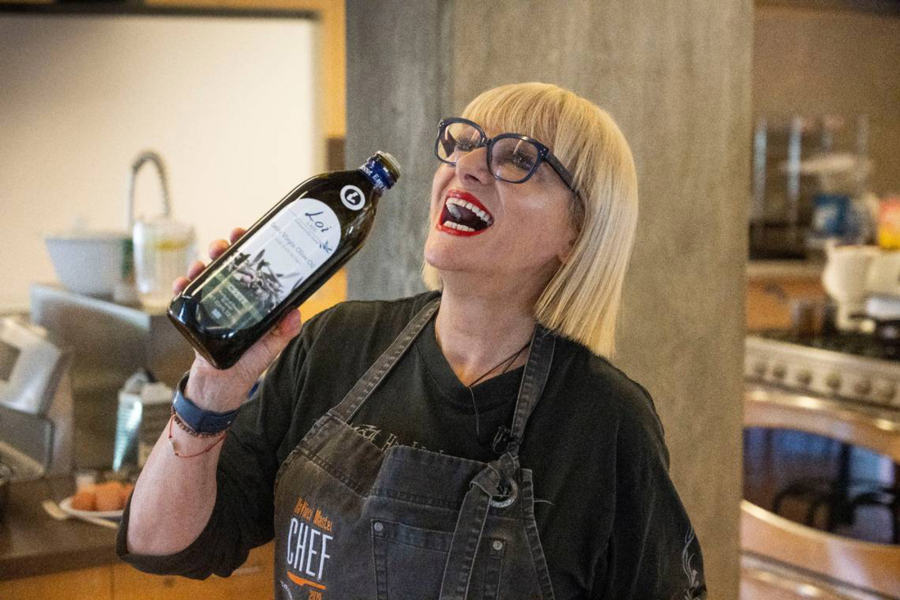DAVIS, Calif. — UC Davis Olive Center executive director Javier Fernandez Salvador had hoodwinked every student in the room, including the young person who appeared to be a “supertaster.”
Fernandez Salvador instructed everyone at the olive oil tasting to try two oils on the trays in front of them. The first tasted like a standard-issue olive oil; the second was — spicy? “More like a leaf than a nut,” said the possible supertaster in the second row, to the instructor’s delight.
And which one did the class prefer, Fernandez Salvador asked? The vast majority of students said they liked the familiar flavor of oil No. 1.
At the front of the classroom, his olive-print face mask sewn by one of his students hid his amusement. “Now we get the bad news: The first oil was a quality oil, but it’s about three years old,” he said. “And it’s rancid.”
It was “rancid, rancid, rancid,” he said, but no one suspected it, and lots of people liked it. The proselytizers at the Olive Center are trying to change that — in part by feeding has-been extra virgins to unsuspecting students.
Fernandez Salvador was one of three instructors at a two-day class on the UC Davis campus geared toward “olive-curious youth.” The co-instructors, chefs and authors Maria Loi and Jehangir Mehta, appeared less prone to deception. But they were united in a desire to save the 15 or so young people in the audience from a terrible fate: getting used to bad olive oil and, thus, preferring it.
“We need to get you started,” Fernandez Salvador said, “as youth.”
And so he was piloting this class at the center — the first aimed specifically at young people — and instructing students in sensory evaluation of olive oils.
The proper way to taste olive oil, Fernandez Salvador said, was to start by warming it up to (ideally) 82 degrees Fahrenheit with the warmth of your hand. When the temperature of the glass seems to match the temperature of your hand, he said, “It’s ready to be sniffed.”
Swirl your oil around in a blue glass, he advised the students, so you won’t be biased against green oils for no reason. Give it a deep whiff, then put it in your mouth and suck in some air through your teeth. Then, holding the oil in your mouth, exhale through your nose so that you’re smell-tasting it.
One time, he said, Fernandez Salvador tried demonstrating this with olive oil in front of a class; because he had made such a big deal about how easy it was, he literally choked under pressure. On this day, he used water.
More than two dozen students — adults and youth — in his classroom Aug. 11 ate a little bite of a green apple to cleanse their palates, then swallowed a mouthful of olive oil in unison, just like he said.
A good oil often has a peppery aftertaste, the students learned, and it should be consumed quickly. You should store it somewhere cool — outside the cooking process, heat is bad for the flavor. If you want the freshest oil, buy local oils. The olive oil on your shelf at home is probably too old, and it might be downright bad.
Before the class went outside to harvest fruits, herbs and vegetables from the garden to make a pita pizza (with — what else — a lot of olive oil), everyone got a tiny plastic cup with a bite of vanilla bean ice cream inside. Fernandez Salvador had indicated some non-rancid oils at this point in the day, and suggested pouring a beautiful Tunisian variety on top of the ice cream. Life, like olive oil, can be full of surprises, and the ice-cream-and-oil combination was delicious.
Fernandez Salvador told the suspected “supertaster” to get tested for special tasting abilities. (“We do that upstairs,” he noted.) And then he told everyone that it takes time to train your palate, and it was OK, he reassured the class, to like the bad oil: “Your palate is used to that.”
But, he said, “If you start recognizing great extra virgin olive oil versus a rancid at age 6, 7, 8, 10, 12, you are a connoisseur when you get to age 30. If you start tasting at age 30, it’s a completely different journey.”
However, he himself didn’t discover good oil until adulthood, and he hasn’t lost hope for 30-year-olds. “Don’t feel bad,” he said. “Because you’re learning.”



